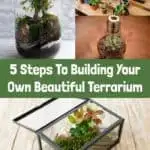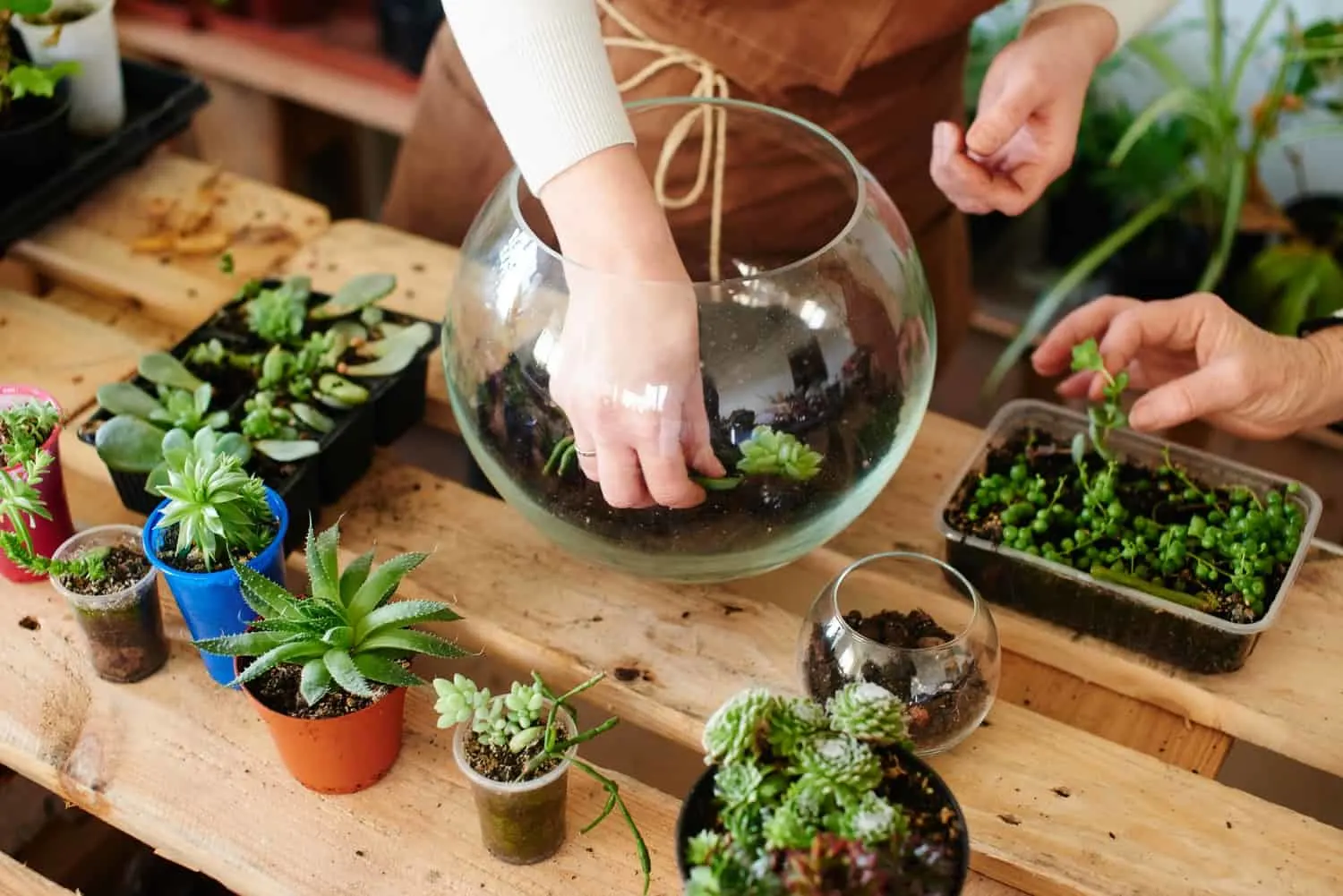
Terrariums are the perfect way to spruce up your home with a little greenery.
They don’t take up much space, don’t need a lot of care, and add a wonderful whimsical quality to any space they’re part of. The best part is, terrariums are incredibly easy to care for and even the most gardening inept can find success.
You can build a terrarium in just a few minutes. It’s a great project to do with the kids!
Terrariums make great gifts for a housewarming or favors for a party.
Pin This To Save For Later
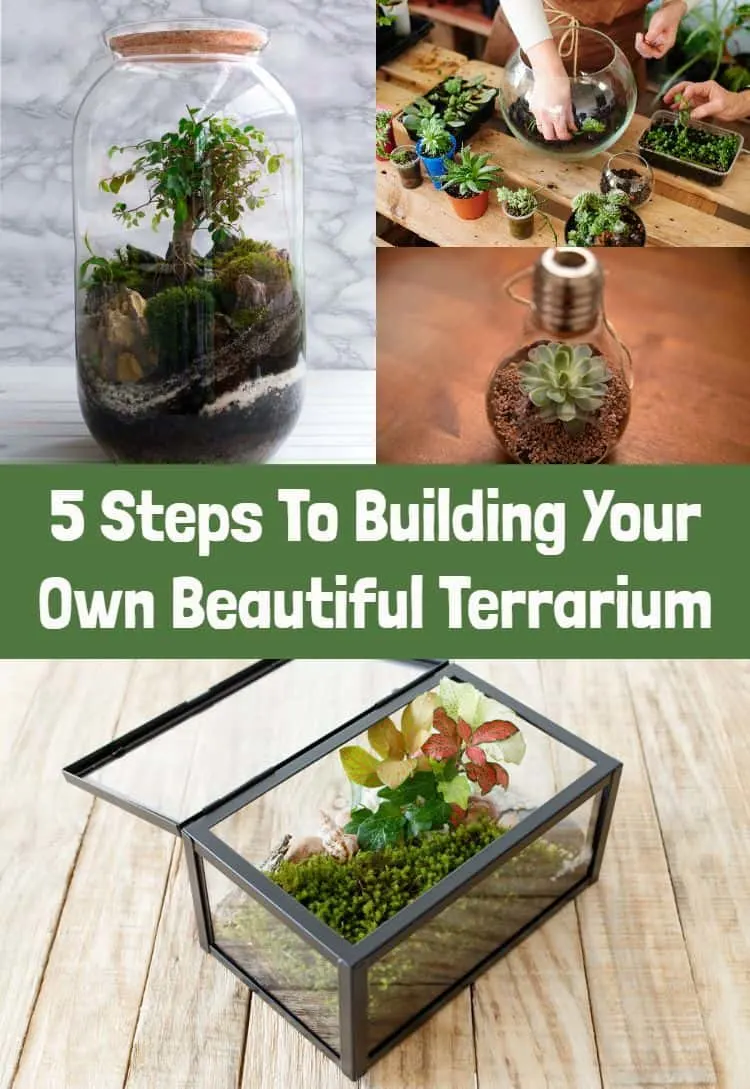
What You’ll Need For Your DIY Terrarium:
- Glass container
- Pebbles
- Activated charcoal
- Potting soil
- Plants
Container Options
One of the best ways to get creative with your DIY terrarium is in choosing the container to build your tiny ecosystem.
The only real requirement for the container is that it’s made of glass. Other than that, the choice is yours! You could build a tiny plant world inside of a salt shaker or a vast one in a table top greenhouse.
The type of container you choose will also determine whether you’re going to grow an open or a closed terrarium.
An open terrarium doesn’t have a top, which allows air flow and water evaporation. Open terrariums need to be watered regularly and can sit in direct sunlight without trouble.
A closed terrarium has a lid, which traps air and moisture inside. These terrariums can go long bouts of time without being watered, some have even gone decades without being opened! A closed terrarium creates its own tiny ecosystem. Closed terrariums should be kept in indirect sunlight, so the rays won’t intensify through the glass and bake the leaves of the plants.
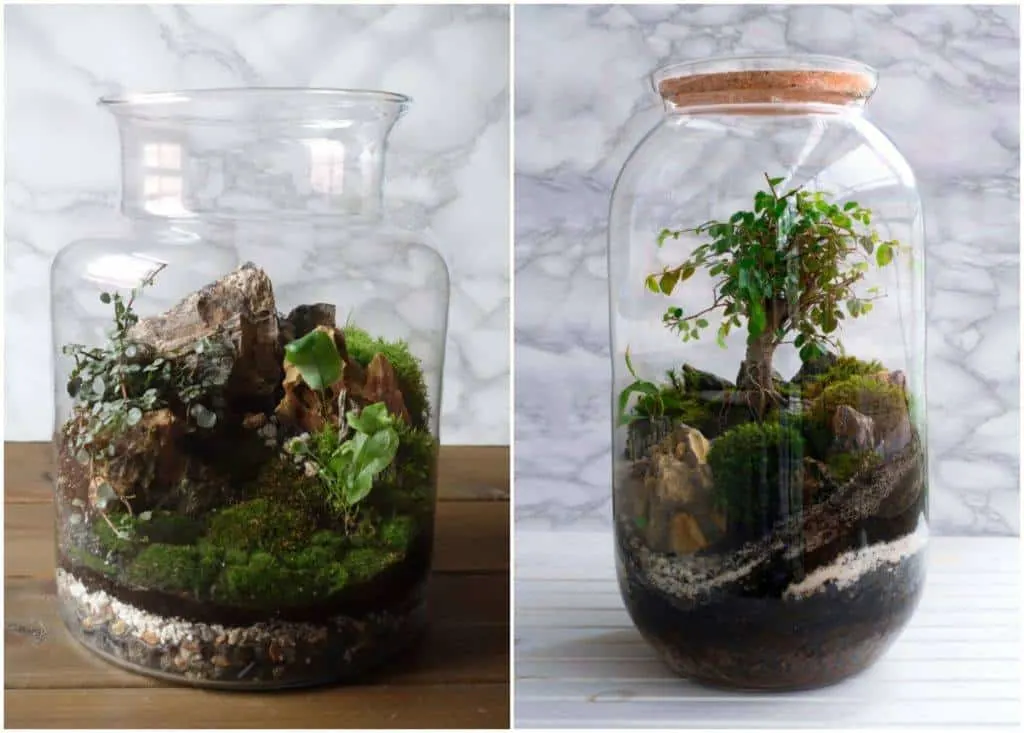
Where to find terrarium containers
Going on the hunt for a container for your new terrarium is one of the best parts of starting one.
There are always lots of good options in the home decor department of popular shops, but a better option would be to buy used. Thrift stores, flea markets, and garage sales are all great places to find containers. They’re usually quite inexpensive, and you’ll likely have a good story behind the adventure of hunting for the perfect container.
15 Terrarium Container Ideas:
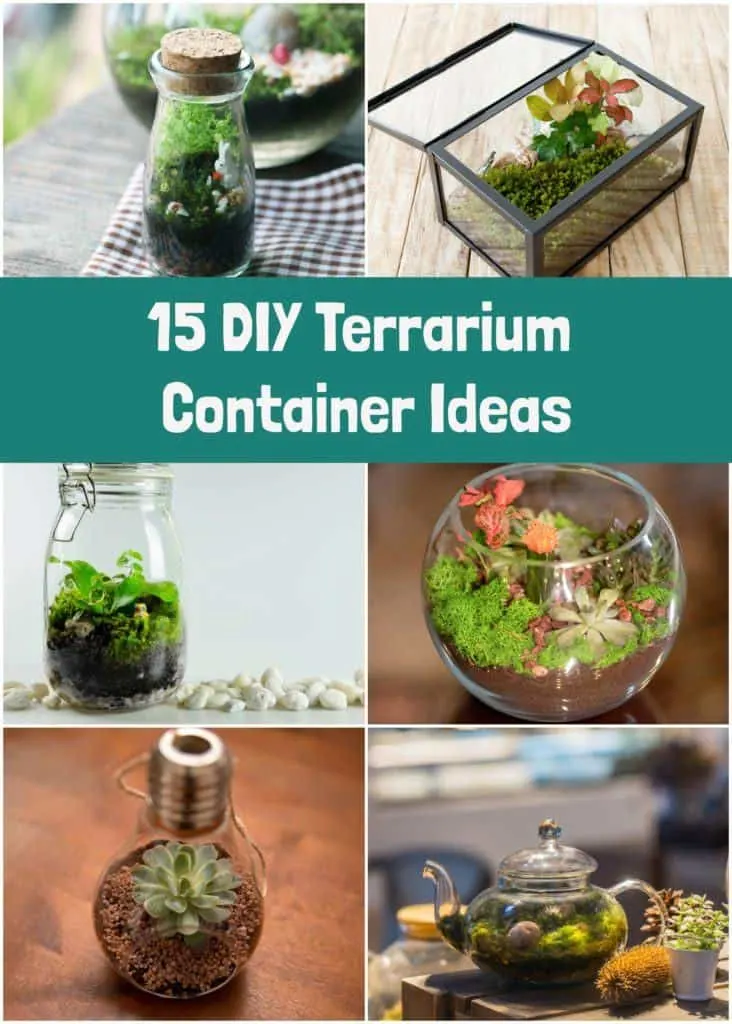
- Bowl
- Bottle
- Cloche
- Coffee Carafe
- Cup
- Glass
- Jar
- Jug
- Lamp
- Lantern
- Lightbulb
- Pitcher
- Salt/Pepper Shaker
- Teapot
- Tabletop Greenhouse
Choosing Plants For Your Terrarium
There are a huge variety of plants that will live happily in a terrarium. Generally you’ll want to select a combination of large and small plants, and mixing up the colors makes a more visually appealing display as well.
One important thing to keep in mind when choosing your terrarium plants is that they need to have the same basic care requirements. Mixing desert plants like cactus with humidity loving plants like African Violet will only end in disaster. All the plants in your terrarium should have the same general watering, feeding, and humidity requirements.
When choosing plants for your terrarium, you’ll need to keep in mind three rules.
- They can’t outgrow the container
- They need to be able to withstand humidity
- They need to thrive in indirect sunlight
14 Best Plants That Will Thrive In Your Terrarium
- African Violet
- Air plants
- Aloe
- Baby’s tears
- Cactus
- Friendship Plant
- Ivy
- Moss
- Pothos
- Prayer Plant
- Sedum
- Spider Fern
- Thyme
5 Steps To Creating Your Own DIY Terrarium
Step 1:
Start by getting your container nice and clean using non-toxic, natural cleaning supplies, or good old fashioned soap and water. Cleaning the container is essential in order to rid the environment of mold and fungus spores that could cause harm to your plants. It also makes the glass nice and clear so you can see your beautiful creation and lots of light can get in to your plants.
Step 2:
Cover the bottom inch or so with a layer of pebbles or stones. This gives the plants proper drainage and prevents root rot.
Step 3:
Put a thin layer of activated charcoal on top of the stones. Activated charcoal will keep bacteria and mold from developing in the terrarium. It can be bought at most garden centers, or on Amazon here.
Step 4:
Layer an inch or two of potting soil on top of the charcoal. Keep in mind that some plants, like cactus and succulents, thrive in special soil. A good rule of thumb is to get organic potting soil without all the added moisture locking or draining ingredients. Basic is best in this case.
At this point the layers should equal about 1/4 of the size of the terrarium.
Step 5:
Start planting the largest or tallest plants first and work the smaller plants around them. This is your chance to get really creative and play with design. Keep in mind also that the plants will need a little room to grow, so don’t overcrowd them.
Optional Step:
This step is entirely optional, but you could have some fun with your terrarium by adding whimsical touches like miniature houses, shells, decorative stones, and figurines.
How To Care For Your Terrarium
Terrariums are generally super easy to care for, they almost thrive on being ignored and have very few requirements.
Sunlight
Always keep your terrarium out of direct sunlight, the glass will intensify any sunlight that hits it and can burn your plants.
Water
If you have an open terrarium, you can water it by pouring water directly into the soil until it’s moist, about once every 1-2 weeks. For a closed terrarium, spray lightly for the first few weeks, then only if the soil gets very dry.
Plant Maintenance
Once a month or so it’s time to do a little maintenance on your plants.
Trimming your plants will keep them small a little longer, and help them to fill out. Also be sure to trim any plants that are close to touching the glass. Remove any dead leaves or branches. If an entire plant is suffering, showing signs of rot, yellowing, browning, or withering, it needs to be removed and replaced.
Popular Gear For Building Your Own Terrarium
Have fun with your whimsical plant-scape!

Get the famous Rural Sprout newsletter delivered to your inbox.
Including Sunday ramblings from our editor, Tracey, as well as “What’s Up Wednesday” our roundup of what’s in season and new article updates and alerts.


